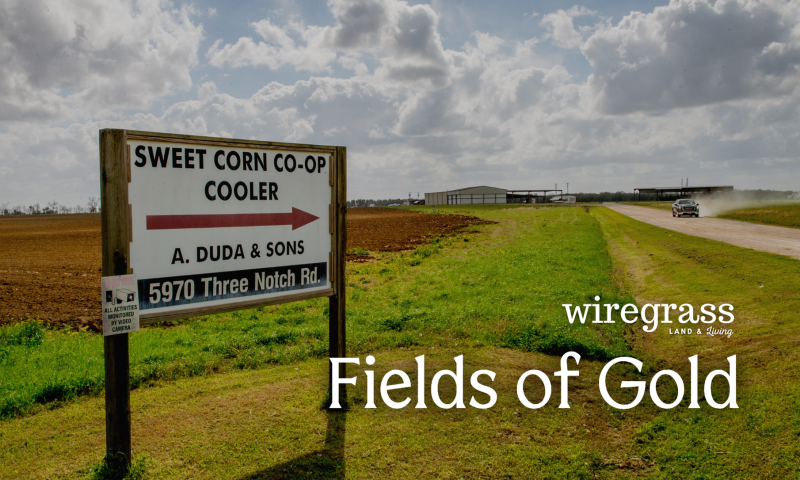Fields of Gold

“A light wind swept over the corn, and all nature laughed in the sunshine.”
Mr. Carl Lynn sits at the table with some old friends and effortlessly starts rattling off names of farmers—farmers in southwest Georgia who have spent a lifetime dutifully planting corn each year. Corn, sweet corn, that is. The bicolor stuff. The juicy mix of yellow and white kernels, cross-pollinated to produce the most succulent of varieties. Appearing locally each year just in time to celebrate our nation’s veterans and our independence. Our local version of fireworks for the tastebuds.
Reaching back to about 1979 or so, Carl Lynn’s memory is like a classic car—built to last, polished to perfection, and ready to take you on a journey. He effortlessly offers more details. All the farmers who planted sweet corn. How many acres they planted. The weather each planting season for the last four decades—and the impact to the crop.
As the story goes, Carl Lynn got his start in the corn “business” when times got tight in the late 70’s. He stopped farming and went to manage a vegetable cooler in Tifton—a long way from his young sons, Turner and Jeff—and his wife, Kay, who held things together back home in Bainbridge. “Those years were tough,” he said. “I thank my family every day for the strength they had during that time.”

Sweet Corn in the Rotation
Mr. Lynn recalls hearing farmers talking about their crop rotation, and the need to add a third crop behind cotton and peanuts. “Everything revolved around peanuts back then—and still does,” he said. In fact, he said farmers have been trying to find the perfect “third” crop for southwest Georgia for a long time—a crop with an available market. Tomatoes, watermelon, carrots and cabbage all require specialized equipment. But corn, all they needed was labor. And with the benefits to soil health, corn seemed like the perfect alternative.
By the mid-90s, Mr. Lynn was ready to move on. He was looking for an opportunity to change vocations. Everything he had learned about vegetables he was ready to commit to a new crop—and that crop was sweet corn.
An Integrated Agribusiness is Formed
When Mr. Lynn put his plan together for the Sweet Corn Co-op located in Iron City, Georgia, it included local growers Glenn Heard, Kim Rentz and Keith and Craig Griffin. Carl became the manager. It was one of the first co-ops in these parts, with all the owners, except Carl, being producers. “I planted for the first two years, and then the management side of things became a full-time job. It truly was an integrated agribusiness,” Carl Lynn said. “It was the first cooler to have more than two owners who harvested, processed, and sold their corn.”
Regional Marketing that Makes Sense for the Consumer
A relationship with A. Duda & Sons, the Oviedo, Florida, agricultural and real estate company, started to form, allowing for additional marketing opportunities for southwest Georgia corn. Duda Farm Fresh Foods, Inc., which is a wholly owned subsidiary of Duda, packages corn under the “Dandy” name, which you can find in grocery stores throughout the area. “Duda wanted a 12-month supply of corn,” Mr. Lynn said. “Corn is a 75-day crop, so southwest Georgia corn was a perfect fit with Florida’s growing season. What we’ve learned,” Lynn continued, “is that consumers want corn all year long. They expect to see it on grocery shelves in February and March, as much as they want to grill it with their hot dogs on the Fourth of July.”

Trucks for Miles
On the busy days at the Sweet Corn Co-op, trucks line the long drive, waiting to get loaded with the maize, with its young and tender kernels. It hits the store shelves fully fresh, ready for consumers, three-to-five ears in a tray pack, convenient for the modern household to buy and prepare. Southwest Georgia corn is shipped all over the world, thanks in part, to marketing skills Mr. Lynn has brought to the business.
“I’m not an innovator,” he said. “But I am an adapter. And that’s one thing we’ve been able to do here. We’ve made good business decisions that have allowed us to grow, and it’s had an impact on our local economy.”
By the Numbers
Southwest Georgia is a significant producer of fresh market sweet corn, with over 21,000 acres harvested annually. The region’s commercial sweet corn production is concentrated in Decatur and Mitchell counties, which account for 80% of the state’s shipper sweet corn production.
Sweet corn is the second most valuable vegetable crop in Georgia. The varieties grown in the region include bicolor, yellow, and white. The crop is primarily intended for the wholesale shipping market, where it is harvested, boxed, cooled and shipped to retailers.
Pricing Trends
Sweet corn pricing is quite dynamic. In a normal year, corn prices range from $10 to $14 per box. Of course, whenever there is a weather event, market disruptions can occur, and the price of corn can spike.
Aggregated across the region, gross production value can exceed $100 million in strong years, providing an essential revenue stream for many producers in the area.
Impact on Local Economies
The economic influence of this crop extends well beyond the fields. The revenue generated by sweet corn creates a ripple effect through local communities:
- Employment: Farm labor, harvesting crews, and processing teams directly benefit from the seasonal work. This, in turn, stimulates related sectors such as logistics, transportation, and retail.
- Ancillary Industries: Local businesses including seed suppliers, equipment dealers, refrigerated transport fleets, and packing facilities rely on sweet corn production. These industries enjoy steady demand, which supports business growth and fosters innovation in agricultural services.
- Community Investment: Healthy farms mean an overall good economic health in the region. A robust sweet corn industry can attract broader investment—from infrastructure improvements to enhanced storage and transportation networks.
Sweet corn production in Southwest Georgia is not just a source of farm income—it’s a robust engine that drives the local economy in several dynamic ways.
If you build it...
And so, beneath the wide southern sky, the fields of southwest Georgia stretch golden in the afternoon sun—proof that if you build it, growth will come. It’s a testament to tradition, resilience, and trust; relationships and partnerships. Mr. Lynn knows the value in that—over decades—a lifetime really. A dream of faith and abundance, sown and reaped, year after year. His belief that hard work always yields a harvest has never failed him.
🌽 Sweet Corn Perfection!
There’s really no single best method to prepare it—it depends on the flavor and texture you’re after. However, many folks agree that grilling brings out the sweetest, most satisfying taste in fresh, sweet corn.
For a smoky, charred flavor:
- Try grilling your corn with the husks on. Soak the whole ear in water for about 10-15 minutes before grilling. This helps prevent the husks from burning while vaporizing moisture for an even cook.
- Preheat your grill to medium-high heat. Place the soaked corn on the grill, turning every few minutes so that the husks get charred evenly. After about 10-15 minutes, the kernels inside should be tender and infused with a smoky flavor.
- For extra depth, peel back the husks slightly, brush the kernels with melted butter, and sprinkle a pinch of salt and a squeeze of lime. This step amplifies the natural sweetness, and gives it a fresh, zesty finish.
Carl Lynn's Simple Recipe
Take it from a man who has been eating sweet corn his whole life. Want a juicy ear of corn? Try this:
- Bring a large pot of water to a boil. Add a small pinch of salt.
- Once boiling, add your fresh ears of corn without the husk. Cook for about 2-3 minutes. The kernels will be tender and retain their inherent sweetness.
- Drain quickly and serve hot with plenty of butter.
Enjoy!